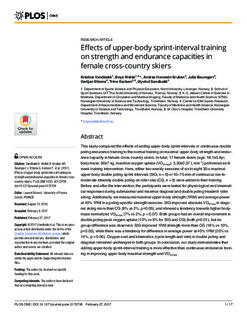| dc.contributor.author | Vandbakk, Kristine | |
| dc.contributor.author | Welde, Boye | |
| dc.contributor.author | Hovstein, Andrea | |
| dc.contributor.author | Baumgart, Julia Kathrin | |
| dc.contributor.author | Ettema, Gertjan | |
| dc.contributor.author | Karlsen, Trine | |
| dc.contributor.author | Sandbakk, Øyvind | |
| dc.date.accessioned | 2017-10-30T14:50:19Z | |
| dc.date.available | 2017-10-30T14:50:19Z | |
| dc.date.created | 2017-08-04T13:33:53Z | |
| dc.date.issued | 2017 | |
| dc.identifier.issn | 1932-6203 | |
| dc.identifier.uri | http://hdl.handle.net/11250/2462956 | |
| dc.description.abstract | This study compared the effects of adding upper-body sprint-intervals or continuous double poling endurance training to the normal training on maximal upper-body strength and endurance capacity in female cross-country skiers. In total, 17 female skiers (age: 18.1±0.8yr, body mass: 60±7 kg, maximal oxygen uptake (VO2max): 3.30±0.37 L.min-1) performed an 8-week training intervention. Here, either two weekly sessions of six to eight 30-s maximal upper-body double poling sprint-intervals (SIG, n = 8) or 45–75 min of continuous low-to-moderate intensity double poling on roller skis (CG, n = 9) were added to their training. Before and after the intervention, the participants were tested for physiological and kinematical responses during submaximal and maximal diagonal and double poling treadmill roller skiing. Additionally, we measured maximal upper-body strength (1RM) and average power at 40% 1RM in a poling-specific strength exercise. SIG improved absolute VO2max in diagonal skiing more than CG (8% vs 2%, p<0.05), and showed a tendency towards higher body-mass normalized VO2max (7% vs 2%, p = 0.07). Both groups had an overall improvement in double poling peak oxygen uptake (10% vs 6% for SIG and CG) (both p<0.01), but no group-difference was observed. SIG improved 1RM strength more than CG (18% vs 10%, p<0.05), while there was a tendency for difference in average power at 40% 1RM (20% vs 14%, p = 0.06). Oxygen cost and kinematics (cycle length and rate) in double poling and diagonal remained unchanged in both groups. In conclusion, our study demonstrates that adding upper-body sprint-interval training is more effective than continuous endurance training in improving upper-body maximal strength and VO2max. | nb_NO |
| dc.language.iso | eng | nb_NO |
| dc.publisher | Public Library of Science | nb_NO |
| dc.rights | Navngivelse 4.0 Internasjonal | * |
| dc.rights.uri | http://creativecommons.org/licenses/by/4.0/deed.no | * |
| dc.title | Effects of upper-body sprint-interval training on strength and endurance capacities in female cross-country skiers | nb_NO |
| dc.type | Journal article | nb_NO |
| dc.type | Peer reviewed | nb_NO |
| dc.description.version | publishedVersion | nb_NO |
| dc.source.volume | 12 | nb_NO |
| dc.source.journal | PLoS ONE | nb_NO |
| dc.source.issue | 2 | nb_NO |
| dc.identifier.doi | 10.1371/journal.pone.0172706 | |
| dc.identifier.cristin | 1484231 | |
| dc.description.localcode | © 2017 Vandbakk et al. This is an open access article distributed under the terms of the Creative Commons Attribution License, which permits unrestricted use, distribution, and reproduction in any medium, provided the original author and source are credited. | nb_NO |
| cristin.unitcode | 194,65,25,0 | |
| cristin.unitcode | 194,65,30,0 | |
| cristin.unitname | Institutt for sirkulasjon og bildediagnostikk | |
| cristin.unitname | Institutt for nevromedisin | |
| cristin.ispublished | true | |
| cristin.fulltext | original | |
| cristin.qualitycode | 1 | |

